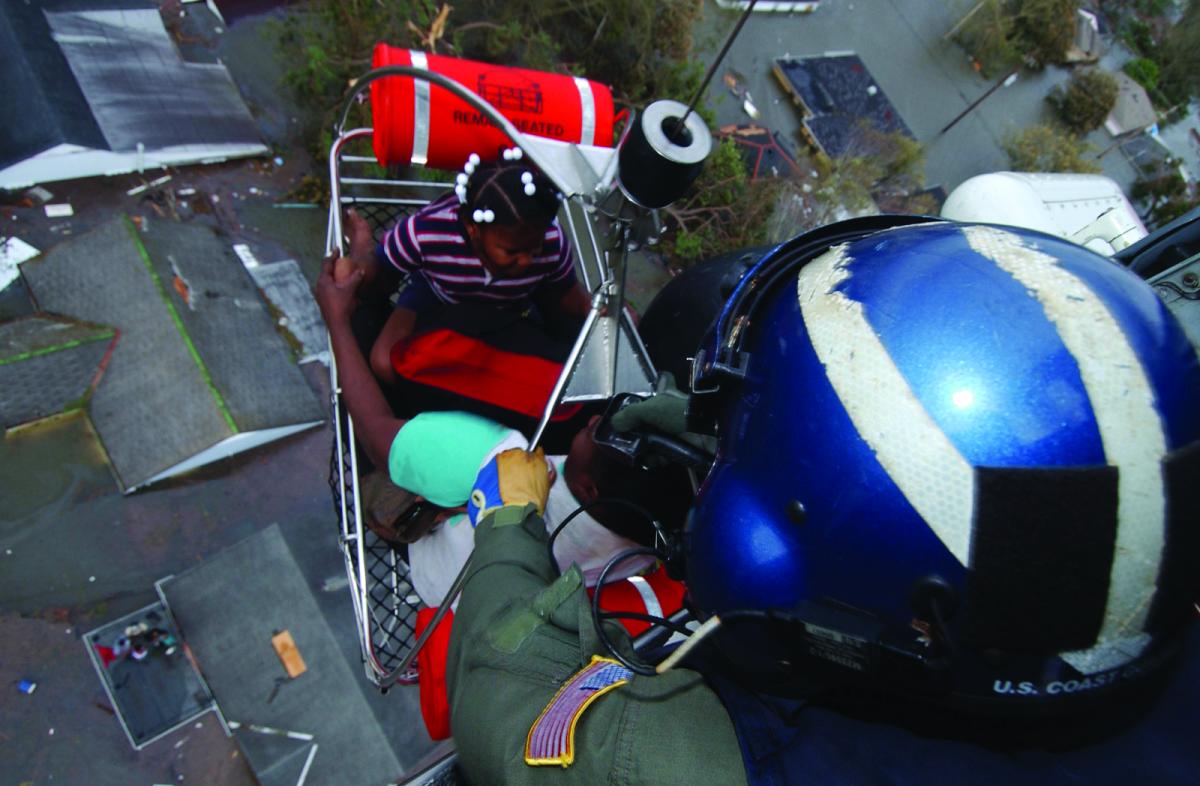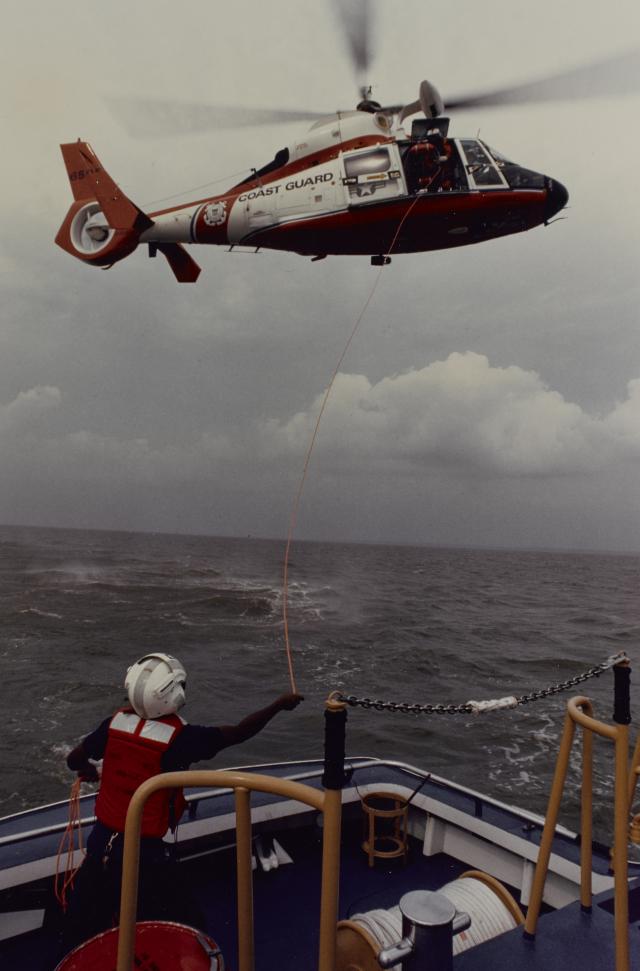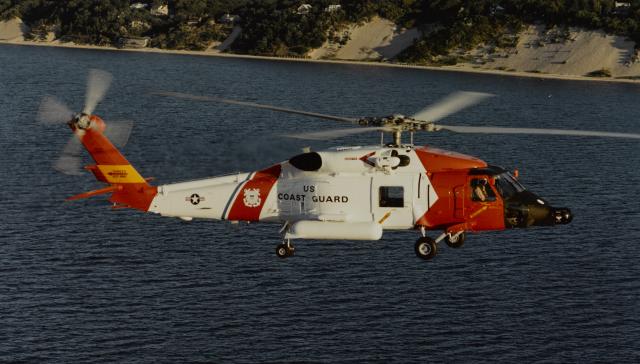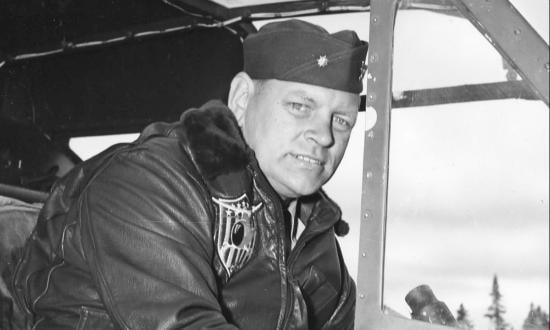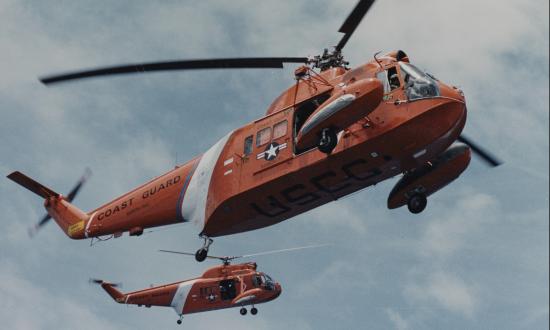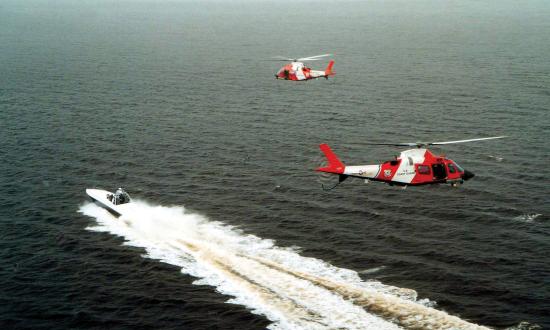‘Yes, I Can’
The first Coast Guard swimmer lifesaving mission unfolded on 10 December 1987, when at 1936 a 26-foot fishing vessel named the Bluebird requested assistance. The duty helicopter crew at Coast Guard Air Station Sitka, Alaska, quickly boarded HH–3F number 1486 and prepared to fly directly into a quickly developing storm at near-hurricane strength. Lieutenant Commander John Whiddon, Lieutenant Greg Breithaupt, Aviation Machinist’s Mate First Class Carl Saylor, Aviation Electronics Mechanic Third Class Mark Milne, and Aviation Support Equipment Technician Mechanical Second Class Jeff Tunks were airborne in 17 minutes, immediately buffeted by 60-knot winds, snow, and ice.
Jim Blades and his six-year old son, Clint, were on board the Bluebird, which was near mountainous terrain with visibility less than a half-mile. The helicopter quickly arrived on scene, but it could not maintain a stable hover because of the strong, shifting winds and turbulence. Lieutenant Commander Whiddon used up to 123 percent power and the entire range of flight controls in his attempt to keep the aircraft steady. The nose pitched up and down 20 degrees, and altitude changes of 100 feet were almost constant, along with 20-degree rolls. The aircraft was pushed backward several times. The basket could not be lowered to the deck, so Whiddon told Blades and his son to get in the water. Both were wearing survival suits, and Blades strapped his son to himself.
Nearly losing control of the helicopter several times, Whiddon asked Tunks if he would get into the water to assist the survivors. Even though his training at the U.S. Navy’s Aviation Rescue Swimmer School had never prepared him for conditions such as this, he answered, “Yes, I can.” From a 60-foot hover, a horse-collar sling lowered Tunks into the freezing water, where he helped Blades and the boy stay afloat.
After several attempts, the wildly swinging basket finally came within reach, and Tunks rolled both survivors into it. After they were hoisted aboard the helicopter, Tunks managed to grab the outside of the basket and hung on until he was also safely aboard. This outstanding rescue mission clearly showed the value of the new rescue-swimmer program.
All Out Effort
The eye of Hurricane Katrina made landfall on the Gulf Coast early in the morning of 29 August 2005. The storm affected 6,400 miles of shoreline and created 90,000 square miles of destruction—an area larger than Great Britain. It was by far the worst U.S. disaster ever experienced, with an approximate total loss of $125 billion.
U.S. Coast Guard helicopters from Aviation Training Center Mobile, Alabama; Coast Guard Air Station New Orleans; and Coast Guard Air Station Houston, Texas, responded as soon as they could. Only nine hours after Katrina’s landfall, as winds still howled at 60 knots, the Coast Guard made its first rescue when an HH-65 helicopter lifted two adults and an infant from a Port Sulphur, Louisiana, rooftop. Additional helicopters and crews flew in from all over the country to assist. At one point, more than 40 Coast Guard helicopters were involved in rescue and recovery operations.
|
HH-65A Dolphin |
|
|
Manufacturer |
Aerospatiale/AIRBUS |
|
Max. gross weight |
9,200 pounds |
|
Range |
400 miles |
|
Engine |
Two Lycoming LTS-101-750B-2 742-hp (each) turboshaft |
|
Max. speed |
165 knots |
|
Fuselage |
Composite |
|
Crew |
4 |
At the rescue peak, Coast Guard helicopters were saving 100 people per hour. Other military and civilian helicopters eventually assisted in rescuing even more people from flooded homes, rooftops, and other dangerous situations. More than 33,000 people received assistance from the Coast Guard during this historic rescue-and-recovery operation. The entire U.S. Coast Guard received the Presidential Unit Commendation for outstanding efforts during the rescue-and-recovery operation associated with hurricanes Katrina and Rita (September 2005).
The Largest Cold-Water Rescue
The 189-foot-long fishing vessel Alaska Ranger sent a distress call at 0252 on 23 March 2008. The vessel was 120 miles west of Dutch Harbor, Alaska, and taking on water rapidly with 47 crew members on board.
The Coast Guard Cutter Munro (WHEC-724) was in the area and prepared to launch her HH-65 helicopter as she headed toward the large, sinking fishing boat. Meanwhile, Coast Guard Air Station Kodiak launched an HH-60 helicopter from St. Paul Island.
The captain of the Alaska Ranger ordered his crew to abandon ship before the helicopters arrived. Crewmen launched their ice-encrusted life rafts, which quickly started to drift away in the high seas and strong winds, forcing the sailors to jump. Some made it into the rafts, but most ended up bobbing in the sea. The Alaska Ranger sank soon after, and all 47 men were at the mercy of the 30-knot winds, 15-foot seas, and the minus 24-degree wind chill. The HH-60 arrived on scene to find the crewmen floating in a half-mile line with their strobe lights blinking in the darkness. Snow squalls further exacerbated the rescue operation.
The Alaska Warrior—a sister ship—also responded to the MAYDAY and started to pick up survivors. The HH-60 saved 12 crewmen by lowering their rescue swimmer into the water. It was impossible to lower the survivors to the nearby Alaska Warrior, so the HH-60 crew decided to fly to the Munro, which was rapidly approaching the scene. By this time, the cutter had also launched her HH-65, and the smaller helicopter started to pick up more survivors. It could fit only four extra men in its cabin, so the crew’s rescue swimmer volunteered to remain in the freezing water so a fifth survivor could be brought aboard the helicopter.
|
MH-60 Jayhawk |
|
|
Manufacturer |
Sikorsky A/C Corp. |
|
Max. gross weight |
22,000 pounds |
|
Range |
700 miles |
|
Engine |
Two GE T700-GE-401c 1,980-hp (each) turboshaft |
|
Max. speed |
160 knots |
|
Fuselage |
Metal |
|
Crew |
4 |
The HH-65 radioed “low fuel” and headed back to the Munro just as the HH-60 completed its in-flight refueling from the cutter. It sped back to the scene and continued to pick up survivors and the rescue swimmer.
At the end of the day, 42 men were rescued. Four others died of hypothermia, and one was never found. This rescue was unprecedented in terms of numbers of people airlifted from the ocean and is considered the largest cold-water rescue in Coast Guard history.
History is made by the dreamers, not the doubters. They take bold risks to alter the status quo. Men such as Admiral Ernest King, Igor Sikorsky, Frank Erickson, and a few other helicopter pioneers (Twirly Birds) changed the course of history. Most senior aviators, who saw only fixed-wing seaplanes as the future for Coast Guard aviation, scoffed at the ideas of Erickson, who stood his ground and proved them wrong. Young military personnel can learn from his example and use their own singular skills and vision to shape the future of our military in the 21st century.



